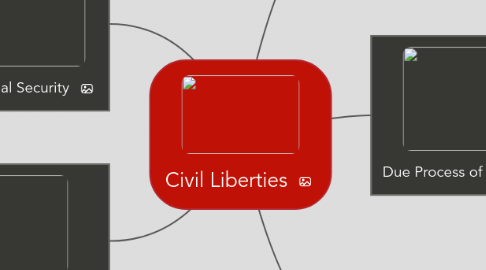
1. National Security
1.1. Students will analyze the inconsistencies that may occur when trying to balance the need for national security and the need to protect civil liberties.
1.1.1. Assessment: The teacher will monitor student progress during group discussion activities. Students will demonstrate their understanding during the goldfish bowl discussion and debate.
1.1.1.1. The teacher will provide students with content relating to NSA surveillance and national security issues.
1.1.1.2. Students will read two articles about Edward Snowden and the concept of whistle blowing and then answer critical thinking questions about the reading.
1.1.1.3. Students will debate and discuss two prompts about NSA surveillance and issues relating to personal privacy as well as the public's right to know about government programs. The debate will be in the form of a goldfish bowl discussion once students choose the side they agree with.
2. Wartime Civil Liberties
2.1. Students will understand that in times of national crisis the government has the power to limit civil liberties and individual rights by evaluating the decision to intern Japanese Americans during WWI.
2.1.1. Assessment:Students work in groups using an online primary source analysis tool. Their responses and analysis of the primary sources will indicate that students are able to read, contextualize, and corroborate more complex text
2.1.1.1. The teacher will demonstrate how to effectively analyze primary sources by providing guided questions to help students read, contextualize, and corroborate complex text.
2.1.1.2. Students analyze three primary sources by answering questions provided on the LOC primary source analysis tool.
2.1.1.3. Students answer critical thinking questions for one of the primary source documents and participate in a whole class discussion.
3. First Amendment
3.1. Students will be able to identify and explain the ways in which their First Amendment rights can be restricted when they come into conflict with the rights of others.
3.1.1. Assessment: Students will work in small groups to determine if censorship of student speech in each scenario is constitutional.
3.1.1.1. Teacher gives lecture presentation on First Amendment freedoms
3.1.1.2. Students complete guided notes and answer critical thinking questions during the lecture presentation
3.1.1.3. Students will participate in a small group activity where they will be asked to analyze two scenarios in which speech is censored in a school setting.
4. Due Process of Law
4.1. Students will demonstrate their understanding of the meaning of due process of law as set out in the 5th and 14th amendments.
4.1.1. Assessment: The teacher will check for understanding by observing pair work (Interpreting the diagram and answering the question). By completing the graphic organizer, students will demonstrate their understanding of important Supreme Court cases that they just read about.
4.1.1.1. The teacher will introduce the vocabulary words for this lesson and pre-read the chapter by reading the headings and sub headings.
4.1.1.2. Students will examine the due process diagram in this section and work with a partner to respond to the question: “Why are procedural and substantive due process both necessary?”
4.1.1.3. Students will create a graphic organizer which will identify at least eight Supreme Court cases students read about in this section, explain its subject matter, and analyze how the Court’s decision relates to due process in terms of police power or right of privacy.
5. Rights of the Accused
5.1. Describe issues that arise from the guarantee of a speedy and public trial, and determine what constitutes a fair trial by jury.
5.1.1. Assessment: Students will write and act out a skit in response to the quote “It is better that ten guilty persons go free than that one innocent person be punished.” Their performance will demonstrate their understanding of the rights guaranteed to people accused of a crime that have read about and discussed in class.
5.1.1.1. The teacher will lead a discussion about the rights of the accused using four Supreme Court cases and also provide instructions to completing a simulation activity.
5.1.1.2. Students will work in groups to read summaries of four Supreme Court cases. For each case, students will answer the questions presented on “The Essential Questions” worksheet and then discuss the significance of each Court ruling.
5.1.1.3. Students will work in their groups to write and perform a skit that portrays either the cost or the benefit to society in pursuing the principle expressed by the quote: “It is better that ten guilty persons go free than that one innocent person be punished.”
